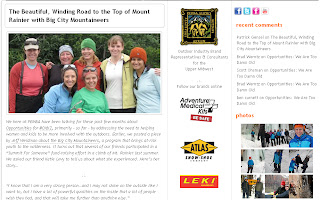 |
| The SteriPEN and solar recharging case. (J. Brown) |
We first met JB, professional climbing guide for SWS and adventurer extraordinaire, back in February when he shared his path to what most of us would consider a dream job. Now he's back, sharing some intimate knowledge of a very important piece of gear for him and his clients during expeditions!
Almost a decade of guiding and climbing in the Himalaya has turned me into an old, bitter skeptic when it comes to water filtration. For almost every year I've spent in those high mountains, I've experienced an equal number of “water purification” misadventures. Nothing, and I mean nothing, ruins a great Himalayan trip faster than almost-purified water. Whether it’s en route in Kathmandu or in the Tea Houses on the approach, bad water can have serious consequences.
For a guide in a third world country, perhaps the greatest issue we face is clean water. We constantly struggle with how to provide copious amounts of safe, clean water to a dozen clients every day affordably and in a manner that minimizes our environmental footprint. You can buy “mineral water” from tea houses and roadside shops, but this can be expensive (up to $4.50 a bottle). Furthermore, most developing nations still don’t have recycling facilities; these bottles will just end up as roadside garbage.
We have tried water filters, but they can be bulky and are often clogged by the glacial silt that is common in the waters of the Himalaya. We even tried the Steripen™, which uses UV light to kill the bacteria and viruses. This has been readily shot down in the past; the first models used AA batteries that were expensive and despite our best efforts would likely end up next to the water bottles as roadside garbage.
This year as we prepped for the Himalaya, I was provided with Steripen’s™ new recharging system. Though it looked complicated, this simple system consisted of the traditional FDA approved pen with two CR123 rechargeable batteries and a carrying case that doubles as a solar recharging system. The charging system is supposed to attach to the top of your pack and recharges the batteries as you hike. (SteriPEN's website says the batteries fully recharge in 20 hours of direct sunlight.)
For fourteen days this year we traveled the Khumbu with throngs of other trekkers and the system worked almost flawlessly. The “bug-zapper” or “light saber”, as it was named by some of our European counterparts, is swirled in the water bottle for up to two minutes while “the wand” emits purple UV light, killing germs. This treatment system coupled with a bandana, to filter out the silt and macro particles, constitutes a pretty effective system.
I couldn’t recommend this single system for more than about five people as the batteries needed to be rotated almost daily, but it worked well for our application. For days that we found snowy or overcast the second battery was enough to get us through and in the event that it wasn’t the system also comes with a plug that can be used in outlets (though we never had to use it). The greatest flaw we came across is the pen tends not to work as well in cold, higher altitudes above 14,000ft. The “bug-zapper” tended to cut out mid-use.
This system isn’t necessarily the best system for every application but can be the perfect system for the international traveler and backpacker. As long as the user can remember to keep it in the sun charging and provided the weather isn’t too extreme for cold and altitude. It works in almost any situation that calls for clean water. I gave it an A-, which isn’t bad for an old skeptical guide.






